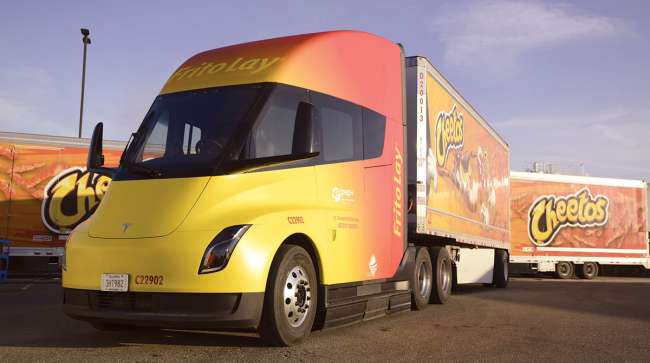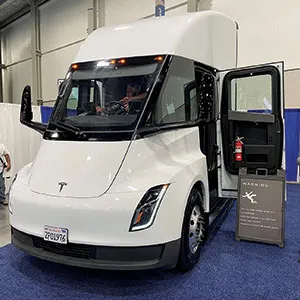Staff Reporter
Tesla Targets Full Semi Production by End of 2026

[Stay on top of transportation news: Get TTNews in your inbox.]
Tesla expects production of its Semi Class 8 tractor to accelerate to full throttle by the end of 2026, according to a senior executive, as the automaker begins to offer more details and express ever more enthusiasm about the vehicle.
The world’s most valuable company by market capitalization previously said Semi production capacity in Reno, Nev., would be 50,000 tractors per year.
Earlier timelines for the start of production of the tractor also are holding steady at present, Vice President of Vehicle Engineering Lars Moravy said during an Oct. 23 earnings conference call. Tesla posted a third-quarter 2024 profit of $2.17 billion, up 17% year on year, and revenue totaling $25.18 billion, up 8%.
“We’re on track to start pilot builds in the second half of next year with production starting in the first half of 2026 and ramping really throughout the year to full production,” Moravy said during the earnings call.
Q3 2024 Earnings Call live at 4:30pm CT https://t.co/FLyk30QBLk — Tesla (@Tesla) October 23, 2024
Those augmentations on what to expect followed comments by Moravy during the world’s most-watched automaker’s first-quarter 2024 earnings call that Reno’s first Semis were expected late this year with customers starting to receive the tractors in 2026.
While executives, including CEO Elon Musk, have tended to concentrate on Tesla’s many other products during recent earnings calls, particularly its artificial intelligence work, Moravy and his boss bantered excitedly about the Semi for the first time during the most recent earnings call.
Moravy first downplayed appetite and expectations for the Semi, saying production growth would depend on customer appetite, but Musk quashed such pragmatism about an upcoming product line.

The Tesla Semi tractor on display at an industry trade show. (Seth Clevenger/Transport Topics)
“I don’t think we’re going to be limited, honestly,” said the world’s richest man. “We have kind of ridiculous demand for the Semi.”
He added, “Yes. Fundamentally, if you’ve got a Semi, the fully considered cost per mile per ton of transport is better than a diesel truck. Any company that doesn’t adopt an electric Semi will lose. It’s not a subjective thing.”
Musk’s enthusiasm and excitement rubbed off on Moravy, a one-time Honda suspension designer who has worked at Tesla for nearly 15 years.
Moravy told analysts and investors that PepsiCo drivers do not want to drive any other truck once they have driven a Semi.
A longtime pioneer in testing the Semi, PepsiCo ranks No. 2 on the Transport Topics Top 100 list of the largest private carriers in North America. PepsiCo operates 12,590 tractors, according to TT data.

Musk
“It’s easy to drive… and it’s fast,” noted Musk, with Moravy replying: “Super fast — maybe too fast.”
“And that’s a benefit not only for the driver and for the goods but also for safety in terms of other drivers on the road. You don’t get stuck behind the Semi; you’re not like in a slowdown situation,” Moravy added.
The Semi was first introduced in 2017, with Musk vowing tractors would be on the road by 2019 and have a ballyhooed range for a battery-electric truck of 500 miles.
Product launch delays are not without precedent in Tesla’s at times rocky history, but the Austin, Texas-headquartered company’s challenge to legacy truck makers is nearing fruition, with Musk promising a global showdown.
On Oct. 15, Musk wrote on the X social media platform he owns that the “Tesla Semi will be available worldwide,” as the tractor was displayed outside Tesla’s Giga Berlin factory.
Construction of the factory for the Semi production lines began in 2023 at the site of the existing Gigafactory Nevada.
Around the same time, Tesla handed over 15 Semis to PepsiCo in Modesto, Calif.
By September 2023, the Semis were showing off their capabilities in the North American Council for Freight Efficiency’s Run on Less-Electric Depot program, with one completing 384 miles on a single charge and 806 miles over 24 hours.
NACFE Executive Director Mike Roeth was impressed.
“The Tesla numbers speak for themselves. They are showing us sort of the future,” Roeth told reporters at the time. “It’s like the art of the probable here; we hear art of the possible, well, this is more the art of the probable, because it is real trucks, real freight.”
Employees at DHL Supply Chain USA — the No. 14-ranked logistics company on the TT Top 100 — also are impressed, they said earlier in October.
During a two-week trial in the summer, DHL integrated the truck into 3,000 miles of normal operations out of Livermore, Calif., including one trip of 390 miles with a gross combined weight of 75,000 pounds on a single charge.
“Our verdict: The Tesla Semi is ready for prime time!” DHL said, adding that it was encouraged by how quickly drivers gained confidence with the vehicle. As a result, the company is looking to integrate more tractors into its network once production begins, the company said.
Want more news? Listen to today's daily briefing below or go here for more info:




